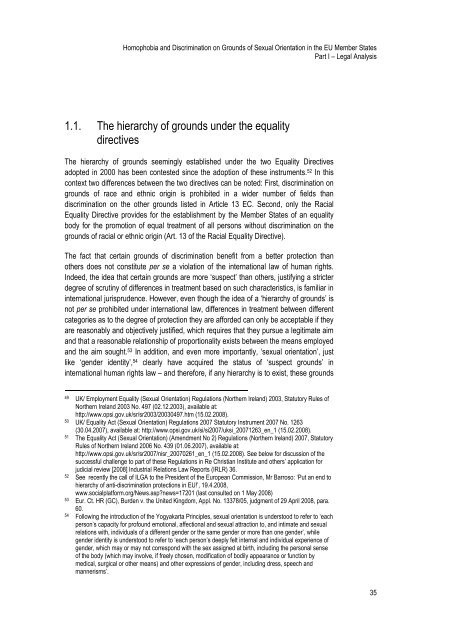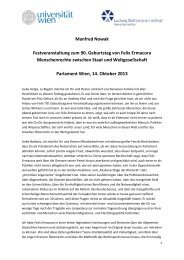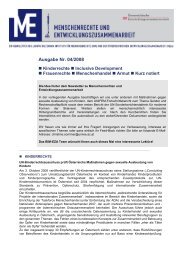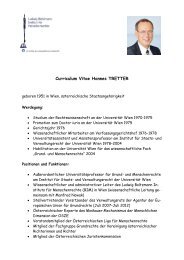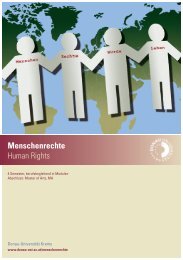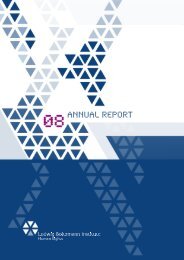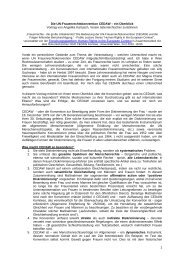Homophobia and Discrimination on Grounds of Sexual Orientation ...
Homophobia and Discrimination on Grounds of Sexual Orientation ...
Homophobia and Discrimination on Grounds of Sexual Orientation ...
Create successful ePaper yourself
Turn your PDF publications into a flip-book with our unique Google optimized e-Paper software.
<str<strong>on</strong>g>Homophobia</str<strong>on</strong>g> <str<strong>on</strong>g>and</str<strong>on</strong>g> <str<strong>on</strong>g>Discriminati<strong>on</strong></str<strong>on</strong>g> <strong>on</strong> <strong>Grounds</strong> <strong>of</strong> <strong>Sexual</strong> Orientati<strong>on</strong> in the EU Member StatesPart I – Legal Analysis1.1. The hierarchy <strong>of</strong> grounds under the equalitydirectivesThe hierarchy <strong>of</strong> grounds seemingly established under the two Equality Directivesadopted in 2000 has been c<strong>on</strong>tested since the adopti<strong>on</strong> <strong>of</strong> these instruments. 52 In thisc<strong>on</strong>text two differences between the two directives can be noted: First, discriminati<strong>on</strong> <strong>on</strong>grounds <strong>of</strong> race <str<strong>on</strong>g>and</str<strong>on</strong>g> ethnic origin is prohibited in a wider number <strong>of</strong> fields th<str<strong>on</strong>g>and</str<strong>on</strong>g>iscriminati<strong>on</strong> <strong>on</strong> the other grounds listed in Article 13 EC. Sec<strong>on</strong>d, <strong>on</strong>ly the RacialEquality Directive provides for the establishment by the Member States <strong>of</strong> an equalitybody for the promoti<strong>on</strong> <strong>of</strong> equal treatment <strong>of</strong> all pers<strong>on</strong>s without discriminati<strong>on</strong> <strong>on</strong> thegrounds <strong>of</strong> racial or ethnic origin (Art. 13 <strong>of</strong> the Racial Equality Directive).The fact that certain grounds <strong>of</strong> discriminati<strong>on</strong> benefit from a better protecti<strong>on</strong> thanothers does not c<strong>on</strong>stitute per se a violati<strong>on</strong> <strong>of</strong> the internati<strong>on</strong>al law <strong>of</strong> human rights.Indeed, the idea that certain grounds are more ‘suspect’ than others, justifying a stricterdegree <strong>of</strong> scrutiny <strong>of</strong> differences in treatment based <strong>on</strong> such characteristics, is familiar ininternati<strong>on</strong>al jurisprudence. However, even though the idea <strong>of</strong> a ‘hierarchy <strong>of</strong> grounds’ isnot per se prohibited under internati<strong>on</strong>al law, differences in treatment between differentcategories as to the degree <strong>of</strong> protecti<strong>on</strong> they are afforded can <strong>on</strong>ly be acceptable if theyare reas<strong>on</strong>ably <str<strong>on</strong>g>and</str<strong>on</strong>g> objectively justified, which requires that they pursue a legitimate aim<str<strong>on</strong>g>and</str<strong>on</strong>g> that a reas<strong>on</strong>able relati<strong>on</strong>ship <strong>of</strong> proporti<strong>on</strong>ality exists between the means employed<str<strong>on</strong>g>and</str<strong>on</strong>g> the aim sought. 53 In additi<strong>on</strong>, <str<strong>on</strong>g>and</str<strong>on</strong>g> even more importantly, ‘sexual orientati<strong>on</strong>’, justlike ‘gender identity’, 54 clearly have acquired the status <strong>of</strong> ‘suspect grounds’ ininternati<strong>on</strong>al human rights law – <str<strong>on</strong>g>and</str<strong>on</strong>g> therefore, if any hierarchy is to exist, these grounds49UK/ Employment Equality (<strong>Sexual</strong> Orientati<strong>on</strong>) Regulati<strong>on</strong>s (Northern Irel<str<strong>on</strong>g>and</str<strong>on</strong>g>) 2003, Statutory Rules <strong>of</strong>Northern Irel<str<strong>on</strong>g>and</str<strong>on</strong>g> 2003 No. 497 (02.12.2003), available at:http://www.opsi.gov.uk/sr/sr2003/20030497.htm (15.02.2008).50UK/ Equality Act (<strong>Sexual</strong> Orientati<strong>on</strong>) Regulati<strong>on</strong>s 2007 Statutory Instrument 2007 No. 1263(30.04.2007), available at: http://www.opsi.gov.uk/si/si2007/uksi_20071263_en_1 (15.02.2008).51The Equality Act (<strong>Sexual</strong> Orientati<strong>on</strong>) (Amendment No 2) Regulati<strong>on</strong>s (Northern Irel<str<strong>on</strong>g>and</str<strong>on</strong>g>) 2007, StatutoryRules <strong>of</strong> Northern Irel<str<strong>on</strong>g>and</str<strong>on</strong>g> 2006 No. 439 (01.06.2007), available at:http://www.opsi.gov.uk/sr/sr2007/nisr_20070261_en_1 (15.02.2008). See below for discussi<strong>on</strong> <strong>of</strong> thesuccessful challenge to part <strong>of</strong> these Regulati<strong>on</strong>s in Re Christian Institute <str<strong>on</strong>g>and</str<strong>on</strong>g> others’ applicati<strong>on</strong> forjudicial review [2008] Industrial Relati<strong>on</strong>s Law Reports (IRLR) 36.52See recently the call <strong>of</strong> ILGA to the President <strong>of</strong> the European Commissi<strong>on</strong>, Mr Barroso: ‘Put an end tohierarchy <strong>of</strong> anti-discriminati<strong>on</strong> protecti<strong>on</strong>s in EU!’, 19.4.2008,www.socialplatform.org/News.asp?news=17201 (last c<strong>on</strong>sulted <strong>on</strong> 1 May 2008)53Eur. Ct. HR (GC), Burden v. the United Kingdom, Appl. No. 13378/05, judgment <strong>of</strong> 29 April 2008, para.60.54Following the introducti<strong>on</strong> <strong>of</strong> the Yogyakarta Principles, sexual orientati<strong>on</strong> is understood to refer to ‘eachpers<strong>on</strong>’s capacity for pr<strong>of</strong>ound emoti<strong>on</strong>al, affecti<strong>on</strong>al <str<strong>on</strong>g>and</str<strong>on</strong>g> sexual attracti<strong>on</strong> to, <str<strong>on</strong>g>and</str<strong>on</strong>g> intimate <str<strong>on</strong>g>and</str<strong>on</strong>g> sexualrelati<strong>on</strong>s with, individuals <strong>of</strong> a different gender or the same gender or more than <strong>on</strong>e gender’, whilegender identity is understood to refer to ‘each pers<strong>on</strong>’s deeply felt internal <str<strong>on</strong>g>and</str<strong>on</strong>g> individual experience <strong>of</strong>gender, which may or may not corresp<strong>on</strong>d with the sex assigned at birth, including the pers<strong>on</strong>al sense<strong>of</strong> the body (which may involve, if freely chosen, modificati<strong>on</strong> <strong>of</strong> bodily appearance or functi<strong>on</strong> bymedical, surgical or other means) <str<strong>on</strong>g>and</str<strong>on</strong>g> other expressi<strong>on</strong>s <strong>of</strong> gender, including dress, speech <str<strong>on</strong>g>and</str<strong>on</strong>g>mannerisms’.35


